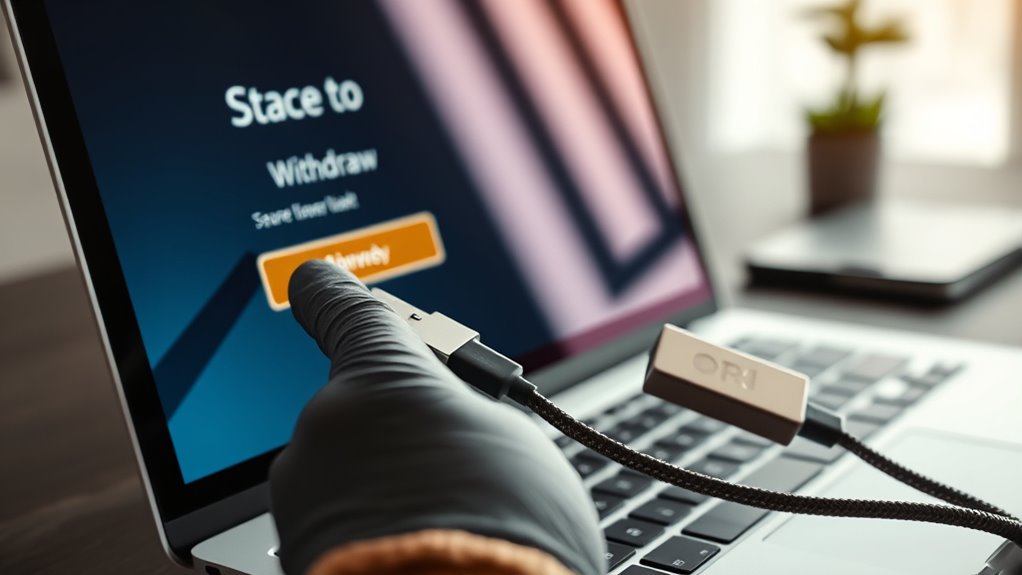To safely withdraw BTC from an exchange and avoid honeypots, you should verify wallet addresses beforehand, use address whitelisting, and double-check for typos to prevent theft. Guarantee your account has strong authentication, and always confirm banking details for fiat withdrawals. Review fees, limits, and processing times carefully. By following these security tips, you protect your funds from scams; further steps to keep your transfers secure will be discussed next.
Key Takeaways
- Verify wallet addresses thoroughly to prevent phishing and clipboard malware risks before withdrawing BTC.
- Use address whitelisting and strong authentication methods to secure withdrawal processes from honeypots.
- Confirm wallet compatibility (SegWit, native addresses) and double-check for typos to avoid losing funds.
- Manage funds carefully by converting to fiat if needed, considering fees, exchange rates, and withdrawal limits.
- Keep detailed records of transaction IDs and receipts to detect and resolve potential honeypot or scam issues later.

Withdrawing Bitcoin (BTC) from an exchange is a critical step for securing your assets and managing your investments effectively. It’s not just about moving funds; it’s about safeguarding your holdings from potential threats like hacks, exchange insolvency, or phishing scams. To do this properly, start by accessing your exchange account and heading straight to the withdrawal or transfer section dedicated to cryptocurrencies. Before initiating any transfer, make sure your external wallet address is added and, if available, utilize address whitelisting. This feature limits withdrawals to trusted addresses, adding an extra layer of security.
Verify that the external wallet address you’re using is compatible with the specific blockchain network supporting BTC. Sending your coins to incompatible addresses or different networks can lead to permanent asset loss. Confirm that the address matches the format for BTC, such as SegWit or native addresses, and double-check it for typos. If you’re converting BTC to fiat currency before withdrawal, sell your BTC on the platform first, then ensure your fiat balance is available and ready. Review the exchange rate and any fees involved to maximize your value. Timing can impact how much you get, so consider market rates and withdrawal costs before proceeding.
When it’s time to withdraw to your bank account, ensure your banking details are correct and verified. This includes IBAN, SWIFT/BIC codes, and other necessary information, especially for international transfers. Choose the appropriate withdrawal method, such as SEPA for Europe or SWIFT for international transactions, based on your bank’s infrastructure. Initiate the transfer and keep in mind that processing times vary from instant to several business days, depending on the platform and bank. Be aware of any withdrawal limits that might restrict larger transactions.
Security should be your top priority during this process. Use strong authentication methods like hardware 2FA devices or authenticator apps. Double-check wallet addresses to avoid falling for phishing scams or clipboard malware that can redirect your funds to malicious wallets. Employ address whitelisting whenever possible to restrict withdrawals to known, trusted addresses. Avoid public Wi-Fi or shared networks during transactions to minimize interception risks. Save all transaction IDs and confirmation receipts for future reference or dispute resolution. Additionally, regularly reviewing potential regulatory compliance requirements can help you stay ahead of legal issues that might affect your withdrawal process.
Finally, factor in the fee structure associated with withdrawals. Different platforms charge varying fees, and these can affect your overall cost. Understanding the fee schedule helps you plan your withdrawals better, especially for large amounts. By following these steps carefully, you minimize risks and ensure your BTC safely reaches your wallet or bank account, helping you avoid honeypots and protect your investments effectively.
Frequently Asked Questions
How Do I Verify the Authenticity of a Withdrawal Request?
To verify a withdrawal request, you should first check for confirmation emails and transaction details like the TxHash or TxID. Confirm the request matches your intended amount and address. Use multi-factor authentication to confirm the transaction, and verify that the withdrawal address is whitelisted or previously verified. Finally, monitor your wallet or blockchain explorer to confirm the transaction’s inclusion and network confirmations, ensuring it’s authentic and secure.
What Are Common Signs of Exchange Security Breaches?
You should watch out for signs like sudden spikes in transaction volume, especially if they involve large or quick withdrawals. Be alert to unusual activity across multiple wallets or frequent cross-chain transfers, which can hide theft. Also, if you notice accounts with little transaction history making large withdrawals or suspicious KYC irregularities, it might indicate a breach. Staying vigilant helps you identify compromised exchanges early and protect your assets.
Can I Recover BTC Lost During a Withdrawal?
Ever wondered if you can recover BTC lost during a withdrawal? It’s possible, but it’s tricky. You need to act fast, double-check transaction details, and use blockchain explorers to track your funds. If the loss is due to errors or congestion, specialized recovery services and blockchain analysis might help. Be prepared for a complex process, and consider consulting professionals or law enforcement if theft or fraud is involved.
How Long Does a Typical Bitcoin Withdrawal Take?
A typical Bitcoin withdrawal takes about 30 minutes to an hour. First, your transaction needs to be confirmed on the network, which usually takes around 10 minutes per confirmation, with most exchanges requiring 3 confirmations. Network congestion or low fees can cause delays. After confirmation, the exchange’s internal processing might add extra time, especially during high demand or maintenance periods. Using higher fees can speed up the process.
Are There Legal Implications When Withdrawing Large Amounts?
When you withdraw large amounts of Bitcoin, you could face legal implications. You might need to report these transactions to authorities to stay compliant with tax laws, especially if they trigger taxable events like selling or converting to fiat. Regulatory agencies monitor big withdrawals for money laundering and AML violations. Failing to report or follow proper procedures can result in fines, penalties, or even criminal charges, so always make sure you handle large withdrawals legally.
Conclusion
Remember, withdrawing your BTC properly is like steering a ship through treacherous waters—you need to stay alert and follow the right path. By taking these steps, you’ll avoid the pitfalls of honeypots and keep your assets safe. Don’t let your crypto journey be a sinking ship; instead, navigate confidently and emerge victorious. Stay vigilant, stay secure, and keep your Bitcoin sailing smoothly toward your goals.









